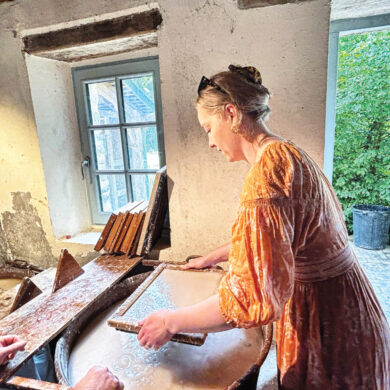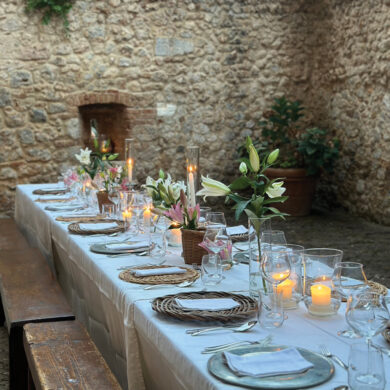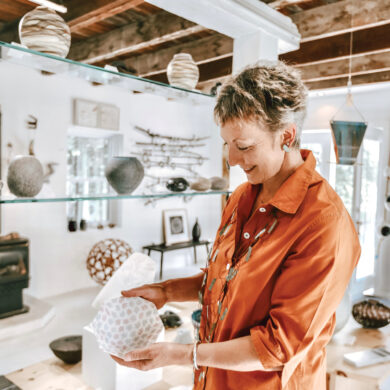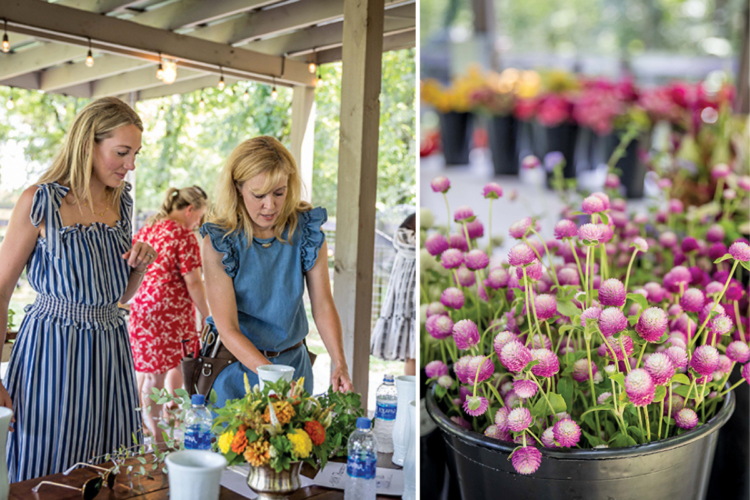
When thinking about the word create, my mind immediately asks the question: How can I produce a product or experience that is new and unique? My creative spaces are broader than those of many artists. They are unique in the fact that they are both indoor and outdoor. Our flower field and farm have become the foundation for the creativity that leads to the development of new products.
You may ask, “How is a flower field a creative space?” Hundreds of hours go into the planning and design of my flower field, which at peak season hosts over 15,000 plants. I look at the field as a blank canvas each season and develop numerous planting layouts that are aesthetically pleasing and balance one another. I achieve this balance by planting flowers with appropriate height, textures and, most importantly, specific colors. Each row includes color blocked flower varieties so that farm visitors notice the dynamic colors of the seasonal blooms.
There is nothing more beautiful than gazing over the flower field and seeing rows of field- planted pink lisianthus, white gomphrena, salmon zinnias and many shades of celosia and other floral varieties. Planting by color in an impactful layout gives our visitors a “wow” moment when they first arrive at the farm and walk into the garden.
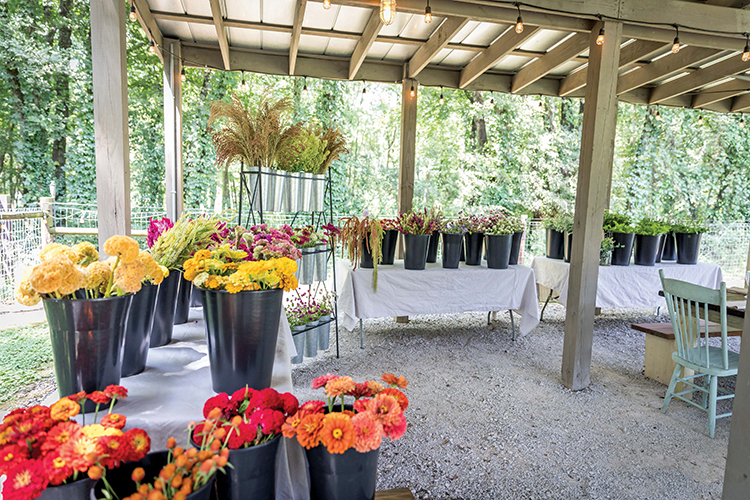
During the summer months, our open-air pavilion is used as a creative space for our Bloom Stroll and Bouquet Workshop participants. This space is multipurpose and serves as an area to both design arrangements for our popular subscription bouquets and process flowers to be hung in our drying room.
The space overlooks our flower field and the Wheeler National Wildlife Refuge. Its Edison lighting and string lights make this creative space a magical place to host events.
I enjoy sharing the creative spaces of both the garden and pavilion during workshops. Guests spend time touring my beautiful garden as I identify my favorite varieties of heirloom flowers and demonstrate the best methods for harvesting flowers when gathering them for arrangements.
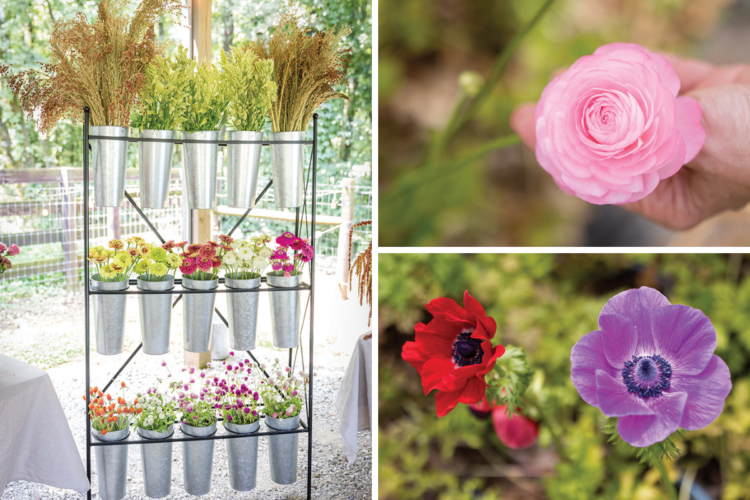
Following the garden tour, participants gather at the 1818 Farms pavilion where the hands-on portion of the workshop will begin. Each participant is provided with a gorgeous selection of fresh cut flowers and herbs gathered that morning at the farm. Next, I discuss the floral elements needed to create a balanced bouquet and demonstrate the basic steps to create a stunning floral arrangement for any occasion. By sharing my creative spaces with others, I hope to inspire them to build a space that brings them joy and where they can create beauty all year long.
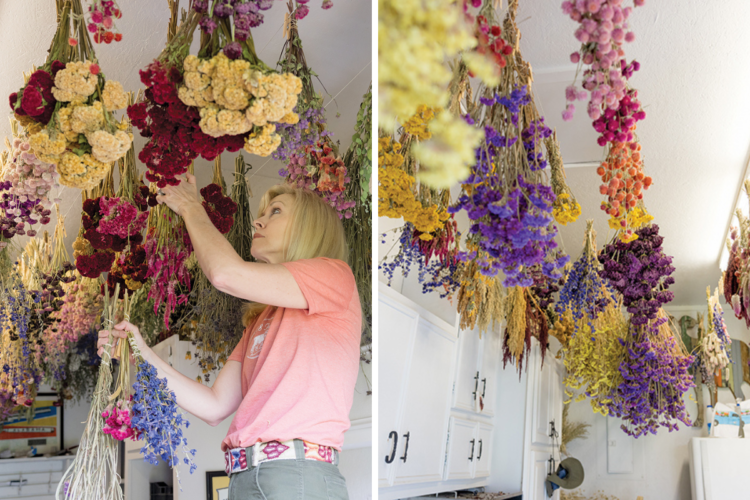
In 2018 I began our farm’s Zero Waste Initiative, which resulted in a new creative space that is used daily throughout the growing season: the 1818 Farms Flower Drying Room. Over the years, I received an increase in requests for dried flower bouquets and wreaths. It was clear that the everlasting flower movement was beginning.
Since opening the farm in 2012, I had always practiced sustainability by adapting a rotational grazing plan for our Babydoll sheep and composting our produce, flowers and farm animal waste.
The Zero Waste Initiative would change the way that I thought of flowers. They would not only be used as fresh cuts but also dried and incorporated as components in our value-added bath and lifestyle product line. Drying our fresh flowers reduced waste and increased the growing/production season and revenue stream.
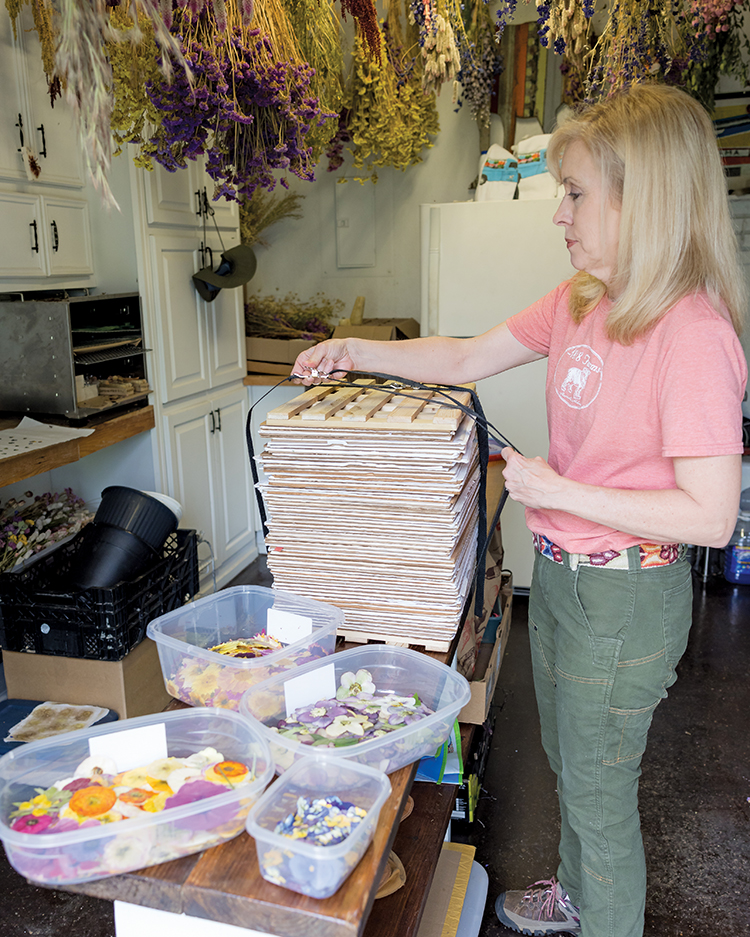
I had one room at the farm that would work perfectly for drying flowers. (The kitchen in our garden house did not have windows and isn’t climate controlled.) To successfully dry flowers, the environment should be dark, warm and dry. These attributes, along with our extremely hot summers and metal roof, create the perfect space for drying beautiful blooms.
To aid in drying, a dehumidifier is constantly running in the room to quickly remove moisture from the flowers. I jokingly refer to the drying room as the “hot box” because it easily reaches 90-plus degrees in the summer.
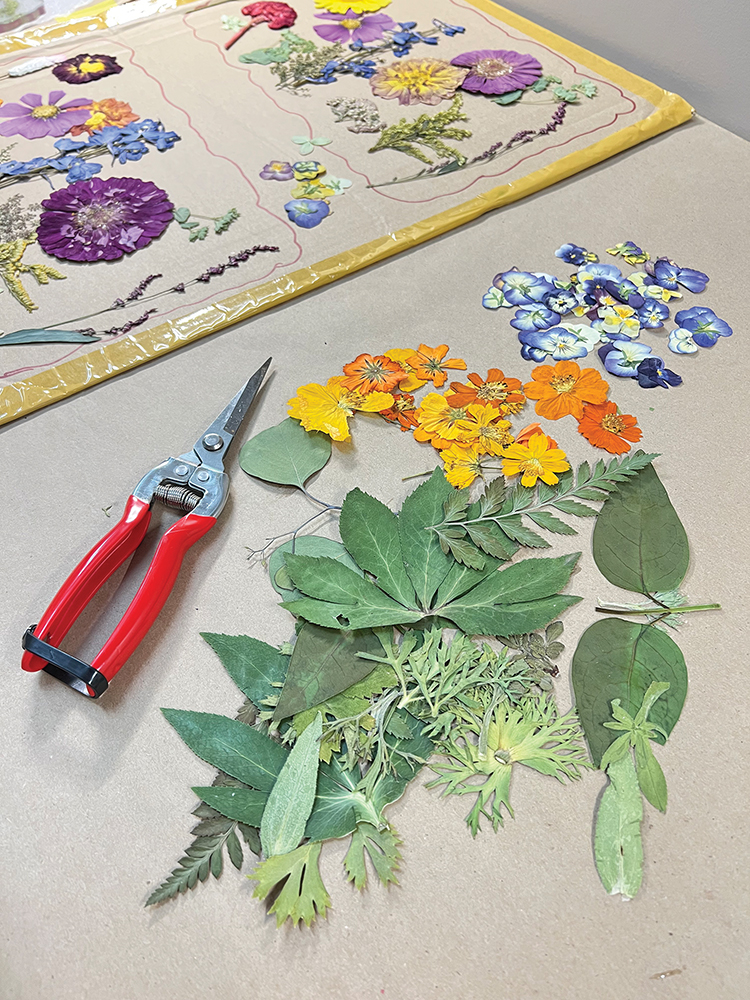
Visitors always ask, “How do your dried flowers have such vibrant color?”
Beautiful flower color is achieved by harvesting and drying flowers that are at their peak. The biggest mistake is people drying flowers that are past their prime. A bouquet that has been in a vase at home for five to seven days is too old to dry. Ninety-nine percent of the time flowers dried at this stage will not dry with vibrant color.
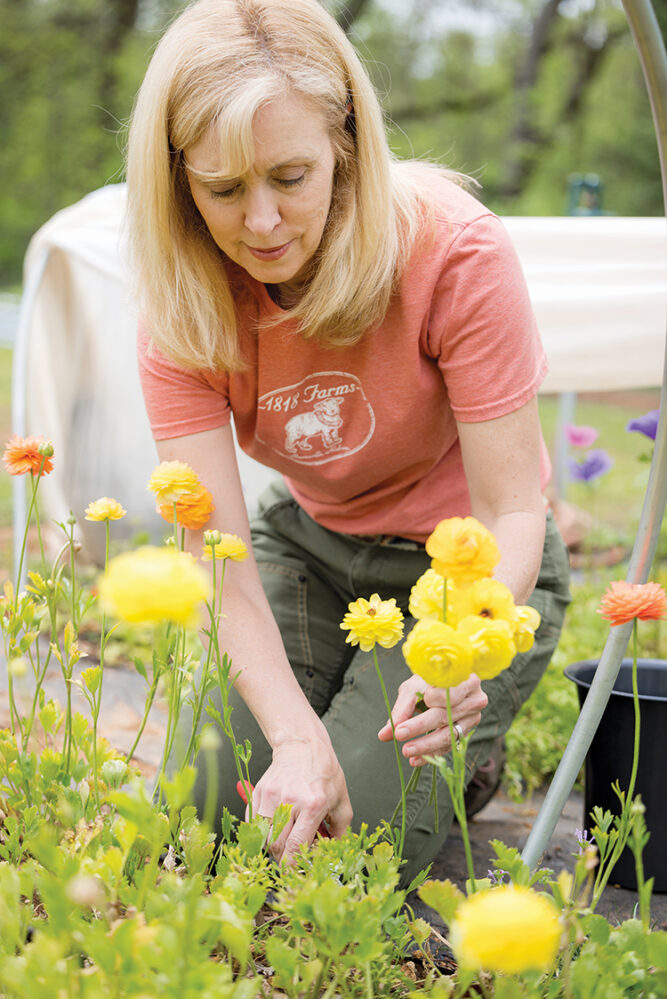
A portion of each summer day is spent harvesting flowers from the field and bundling and hanging them in the drying room. Flower-drying time is quick during the summer months. Most varieties are fully dried in three to seven days.
Once dried, bouquets are either wrapped to sell or are taken to our corporate office where they are incorporated in our beautiful botanical wax sachets.
Our botanical wax sachets are aromatherapy for the home and perfect to freshen any household space. Scented wax sachets are created using a combination of soy and beeswax and fragrance, and beautifully decorated with dried flowers and flower confetti. No two sachets are alike, and each is a unique piece of art.
To further connect the product to the farm, each sachet comes with a conveniently attached yarn hanger that is spun from our Southdown 43 Babydoll sheep wool. A botanical wax sachet is truly from our farm to your home.
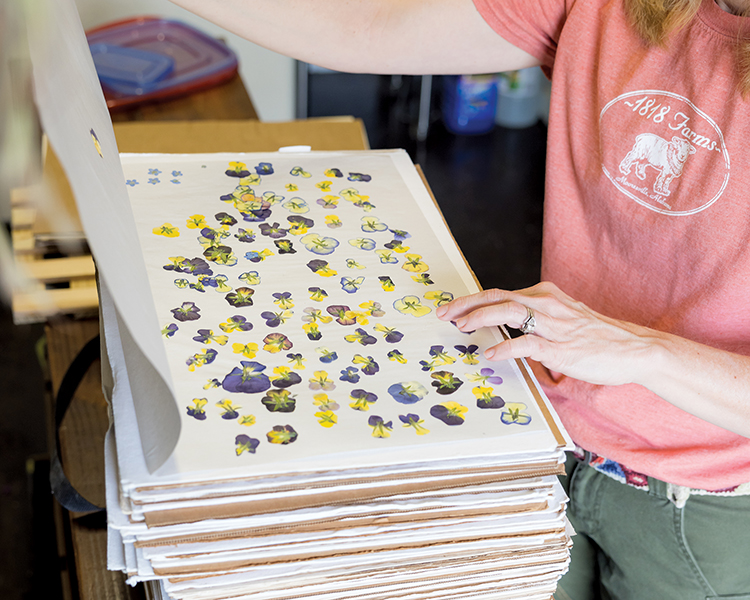
In 2022, I began pressing flowers as well. I became intrigued with the process after discovering my father’s professional-grade flower press from the 1960s. Many of the blotter pages inside the press had hand-written notes about leaf samples taken as early as the 1970s. As a botanist, he obtained extensive knowledge from preserving and documenting leaves and flowers.
My mind began dreaming about the art and beauty that I could create by preserving our farm-grown flowers with a press versus the three-dimensional hanging method. Pressing flowers would also expand our Zero Waste Initiative.
Finding that flower press changed the scale of my product offerings. In 2021, I had been eco-printing textiles using fresh botanicals; but once the growing season was complete, production for the year was finished. I could only eco-print five months of the year.
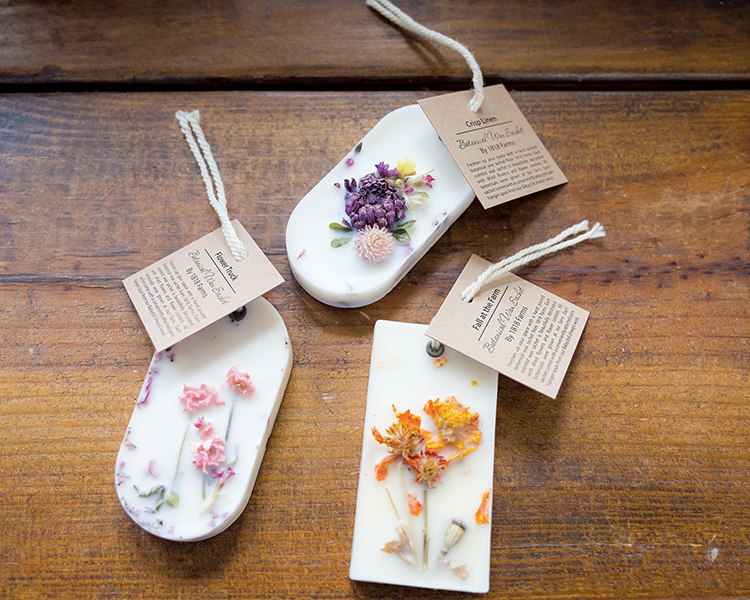
The vintage press encouraged me to immediately begin pressing flowers, leaves and greenery not only for printing textiles but also for creating a line of pressed-flower art pieces, as well as resin jewelry, trays and coasters. This press that had been collecting dust in a barn for many years opened my eyes to the array of creative possibilities available from using my flowers.
As people began to see the pressed-flower artwork, I received custom order requests. I have created resin trays using both funeral and wedding flowers. The pressing process allows me to provide customers with a piece of art that holds significant meaning for a special person or day. It makes me happy to know that I can create artwork that preserves a memory for customers.
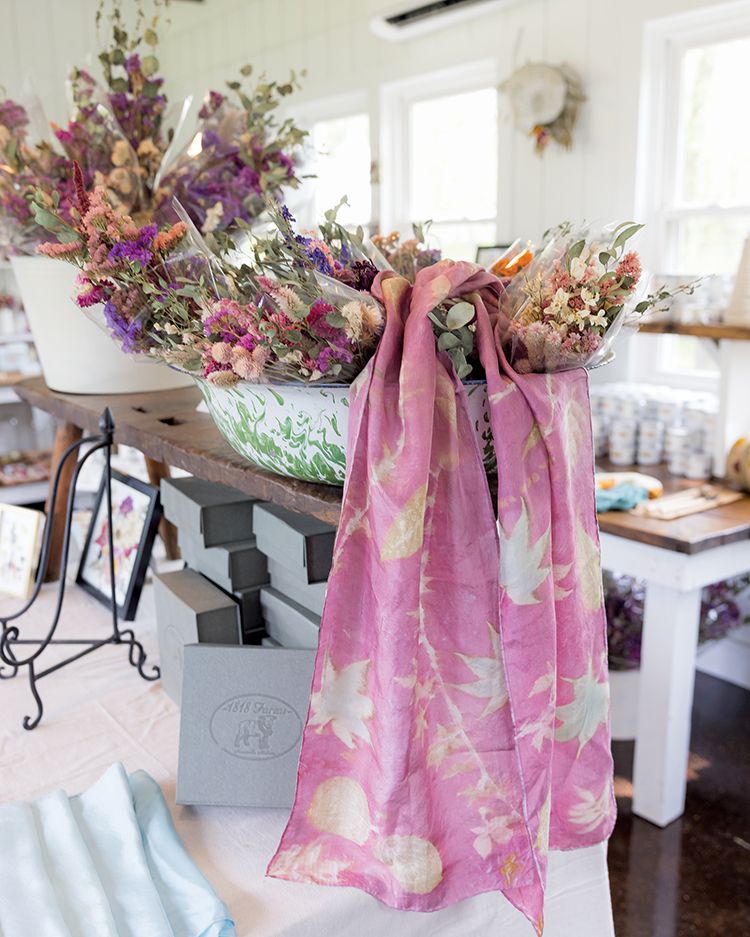
The process of growing and working with flowers — fresh, pressed, and dried — is not always easy. As a farmer, I deal with variables in the environment that I cannot control. Over the years, I have enjoyed many successful growing seasons mixed with a few failures, which I consider learning experiences.
However, at the end of each day, my goal is to provide customers with the highest quality product. Over the past 11 years, I have focused on developing creative spaces that inspire me and help achieve this goal. Sharing my spaces and knowledge with others along the way is icing on the cake.

When thinking about the word create, my mind immediately asks the question: How can I produce a product or experience that is new and unique? My creative spaces are broader than those of many artists. They are unique in the fact that they are both indoor and outdoor. Our flower field and farm have become the foundation for the creativity that leads to the development of new products.
You may ask, “How is a flower field a creative space?” Hundreds of hours go into the planning and design of my flower field, which at peak season hosts over 15,000 plants. I look at the field as a blank canvas each season and develop numerous planting layouts that are aesthetically pleasing and balance one another. I achieve this balance by planting flowers with appropriate height, textures and, most importantly, specific colors. Each row includes color blocked flower varieties so that farm visitors notice the dynamic colors of the seasonal blooms.
There is nothing more beautiful than gazing over the flower field and seeing rows of field- planted pink lisianthus, white gomphrena, salmon zinnias and many shades of celosia and other floral varieties. Planting by color in an impactful layout gives our visitors a “wow” moment when they first arrive at the farm and walk into the garden.

During the summer months, our open-air pavilion is used as a creative space for our Bloom Stroll and Bouquet Workshop participants. This space is multipurpose and serves as an area to both design arrangements for our popular subscription bouquets and process flowers to be hung in our drying room.
The space overlooks our flower field and the Wheeler National Wildlife Refuge. Its Edison lighting and string lights make this creative space a magical place to host events.
I enjoy sharing the creative spaces of both the garden and pavilion during workshops. Guests spend time touring my beautiful garden as I identify my favorite varieties of heirloom flowers and demonstrate the best methods for harvesting flowers when gathering them for arrangements.

Following the garden tour, participants gather at the 1818 Farms pavilion where the hands-on portion of the workshop will begin. Each participant is provided with a gorgeous selection of fresh cut flowers and herbs gathered that morning at the farm. Next, I discuss the floral elements needed to create a balanced bouquet and demonstrate the basic steps to create a stunning floral arrangement for any occasion. By sharing my creative spaces with others, I hope to inspire them to build a space that brings them joy and where they can create beauty all year long.

In 2018 I began our farm’s Zero Waste Initiative, which resulted in a new creative space that is used daily throughout the growing season: the 1818 Farms Flower Drying Room. Over the years, I received an increase in requests for dried flower bouquets and wreaths. It was clear that the everlasting flower movement was beginning.
Since opening the farm in 2012, I had always practiced sustainability by adapting a rotational grazing plan for our Babydoll sheep and composting our produce, flowers and farm animal waste.
The Zero Waste Initiative would change the way that I thought of flowers. They would not only be used as fresh cuts but also dried and incorporated as components in our value-added bath and lifestyle product line. Drying our fresh flowers reduced waste and increased the growing/production season and revenue stream.

I had one room at the farm that would work perfectly for drying flowers. (The kitchen in our garden house did not have windows and isn’t climate controlled.) To successfully dry flowers, the environment should be dark, warm and dry. These attributes, along with our extremely hot summers and metal roof, create the perfect space for drying beautiful blooms.
To aid in drying, a dehumidifier is constantly running in the room to quickly remove moisture from the flowers. I jokingly refer to the drying room as the “hot box” because it easily reaches 90-plus degrees in the summer.

Visitors always ask, “How do your dried flowers have such vibrant color?”
Beautiful flower color is achieved by harvesting and drying flowers that are at their peak. The biggest mistake is people drying flowers that are past their prime. A bouquet that has been in a vase at home for five to seven days is too old to dry. Ninety-nine percent of the time flowers dried at this stage will not dry with vibrant color.

A portion of each summer day is spent harvesting flowers from the field and bundling and hanging them in the drying room. Flower-drying time is quick during the summer months. Most varieties are fully dried in three to seven days.
Once dried, bouquets are either wrapped to sell or are taken to our corporate office where they are incorporated in our beautiful botanical wax sachets.
Our botanical wax sachets are aromatherapy for the home and perfect to freshen any household space. Scented wax sachets are created using a combination of soy and beeswax and fragrance, and beautifully decorated with dried flowers and flower confetti. No two sachets are alike, and each is a unique piece of art.
To further connect the product to the farm, each sachet comes with a conveniently attached yarn hanger that is spun from our Southdown 43 Babydoll sheep wool. A botanical wax sachet is truly from our farm to your home.

In 2022, I began pressing flowers as well. I became intrigued with the process after discovering my father’s professional-grade flower press from the 1960s. Many of the blotter pages inside the press had hand-written notes about leaf samples taken as early as the 1970s. As a botanist, he obtained extensive knowledge from preserving and documenting leaves and flowers.
My mind began dreaming about the art and beauty that I could create by preserving our farm-grown flowers with a press versus the three-dimensional hanging method. Pressing flowers would also expand our Zero Waste Initiative.
Finding that flower press changed the scale of my product offerings. In 2021, I had been eco-printing textiles using fresh botanicals; but once the growing season was complete, production for the year was finished. I could only eco-print five months of the year.

The vintage press encouraged me to immediately begin pressing flowers, leaves and greenery not only for printing textiles but also for creating a line of pressed-flower art pieces, as well as resin jewelry, trays and coasters. This press that had been collecting dust in a barn for many years opened my eyes to the array of creative possibilities available from using my flowers.
As people began to see the pressed-flower artwork, I received custom order requests. I have created resin trays using both funeral and wedding flowers. The pressing process allows me to provide customers with a piece of art that holds significant meaning for a special person or day. It makes me happy to know that I can create artwork that preserves a memory for customers.

The process of growing and working with flowers — fresh, pressed, and dried — is not always easy. As a farmer, I deal with variables in the environment that I cannot control. Over the years, I have enjoyed many successful growing seasons mixed with a few failures, which I consider learning experiences.
However, at the end of each day, my goal is to provide customers with the highest quality product. Over the past 11 years, I have focused on developing creative spaces that inspire me and help achieve this goal. Sharing my spaces and knowledge with others along the way is icing on the cake.











